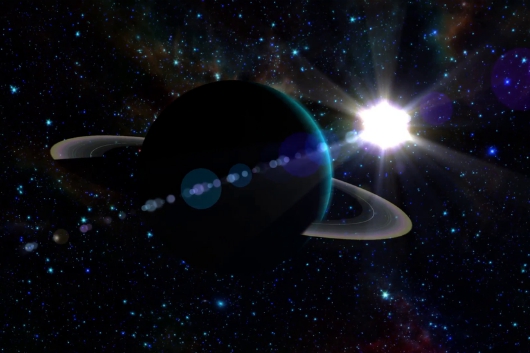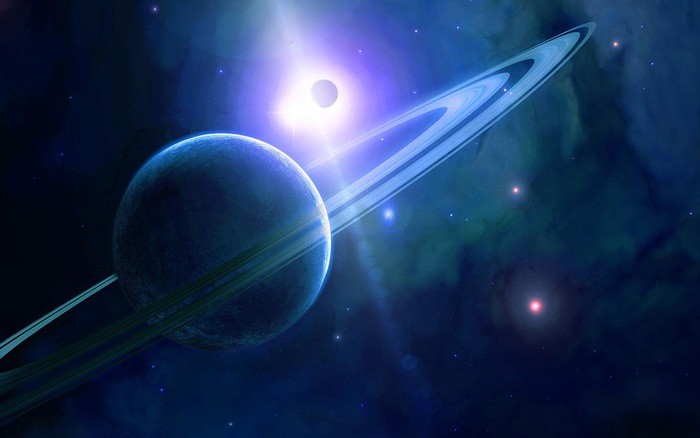The solar system is just a small constellation in the universe that people know best, while there are many more star systems that we have yet to see.
 Exploration of mysterious planets in the universe
Exploration of mysterious planets in the universe
The mysteries of the universe still attract human exploration. With the planets below, hope can bring you an extremely mysterious and strange, even terrifying world.
Solar system of the coldest planet (Uranus)
Uranus was discovered by German astronomer William Herschel (1738-1822) while observing the night sky with a telescope in 1781. He said that Uranus was 10 times darker than other planets and almost impossible to see with the naked eye. Uranus is also the only planet to take its name from a Greek deity (Uranus) instead of Roman mythology.
Physically, Uranus’ mass is nearly 14.5 times that of Earth, but the lightest among gas giants, including Jupiter, Saturn, Uranus, and Neptune. . The atmospheric temperature of Uranus is the coldest of all the planets in the solar system when it is not lower than -224 degrees Celsius, while the lowest part of the Earth’s atmosphere is only -90. degrees Celsius. Many people believe that because Uranus is far from the Sun, Uranus is cold, but this is not necessarily correct as Neptune is the most distant planet, about 4.5 billion km from the Sun against 2.88 billion. . km from Uranus. However, Neptune’s lowest atmosphere temperature is around -217 degrees Celsius, which is still not as high as Uranus.
The reason may lie in the unique configuration with the axis of rotation of the planet tilted at 97.77 degrees, which is almost parallel to the orbital plane of the solar system. During this time, the Earth’s axis of rotation is only about 23.5 degrees. Many theories suggest that Uranus’ axis of rotation is so deflected because an Earth-sized protoplanet crashed into the planet during the formation of the solar system. The powerful impact not only tilted the planet completely, but also caused the core of Uranus to lose a lot of heat and left a structure almost entirely of ice and rock.
The wind speed on Uranus reaches a terrible speed, in which the opposite winds often reach 100 m / s, the same direction turns up to 250 m / s (about 900 km / h). It is also one of the reasons why the planet is unable to retain heat and become cold. The cloud layer of Uranus is quite complex, consisting of a layer containing volatile substances such as water below, ammonia and the upper layer mainly contains methane (the cause of the pale blue color of the planet) , and at the same time May contain small amounts of other hydrocarbons. Moreover, like Jupiter or Saturn, hydrogen and helium are still the two basic components of Uranus, accounting for 82.5% and 15.2% respectively.
Also due to the very different tilt from the rest of the solar system, the seasons of Uranus are also very special. Uranus revolves around the sun once for 84 years on Earth, during which the two poles of the planet were respectively illuminated for 42 years, then plunged into darkness for 42 years.

Uranus has 27 natural satellites known to astronomers. The names of the satellites are chosen from the names of characters in the works of famous Shakespeare and Alexander Pope. The five largest satellites are Miranda, Ariel, Umbriel, Titania and Oberon, of which Titania and Oberon, discovered by William Herschel hundreds of years ago (1787), have a radius of about 788.9 kilometers, or less half of the radius. Earth’s moon.
In 1977, NASA launched the Voyager 2 probe with the goal of understanding four gas planets in the solar system, including Jupiter, Saturn, Uranus, and Neptune over a period of more than 20 years. In 1986, Voyager 2 passed Uranus, about 81,500 km from the clouds in the sky. Voyager 2 studied the structure and chemical composition of the atmosphere, photographed and observed the five largest satellites of Uranus. During the same years, Voyager 2 discovered 10 new Uranian satellites. So far, Voyager 2 is still the only ship to fly over the planet at such low altitudes. Currently, global aerospace agencies have no plans to complete a follow-up project to bring ships to Uranus.
Planets outside the solar system
Planet of the dead
Ancient folk tales say that the aurora are the dancing souls of the dead. If so, imagine a planet completely covered by a magnetic field and whose orbit is very close to its host star.
Scientists believe that planets like these always appear as auroras because plasma rays from their host stars fill their atmospheres.
The Northern Lights here are 100 to 1000 times brighter on Earth, like ghosts dancing across the planet.
Planet alone
There are many exoplanets in the universe, some very small and so far from their host star that conventional telescopes cannot be detected. However, sometimes astronomers are lucky enough to find one of these exoplanets.
The exoplanet MOA-2009-BLG-266Lb is a Super Earth that orbits very far from its host star. But, planet light can be seen from Earth through a microscopic lens, and although very rarely, it can also detect tiny rocky planets far away.
PSO J318.5-22 is another free-floating exoplanet that quickly lost its host star.
These exoplanets beg the question of why they are so far from their host star or if they already have a host star in the first place.
Diamond planet

A full diamond planet might seem like a good idea, but maybe no one will have the chance to walk barefoot on beaches filled with diamonds.
Scientists modeled carbon-rich planets (as opposed to silicon-rich planets like Earth) and found that the amount of carbon these planets make up drains all of their oxygen during the process. Strong. The lack of oxygen means there is no water, so the carbon-rich appearance has no hope of life.
Tailed planet
The exoplanet HD 209458b orbit near its host star, so stellar winds always release the atmosphere into space, creating a comet-shaped tail.
Ghost planet
Kepler-19 is an exoplanet 650 light years away that revolves around a star very similar to the Sun. It has a very strange trajectory, sometimes it moves faster and completes its 9 day 5 minute trajectory faster, and sometimes 5 minutes slower.
This strange orbit is caused by an invisible planet that exerts gravity on Kepler-19. This is the basis for finding planets that still lurk in other star systems.
Zombie planet
Twelve years ago, astronomers using data from the Hubble Telescope claimed to have seen an exoplanet orbiting a star. Upon closer inspection, they found the planet and assumed it was dead.
However, in 2009, an exoplanet called TMR-1C reappeared when observed through a Canada-France-Hawaii telescope. Maybe this alien isn’t dead – he’s just playing hide and seek with scientists


